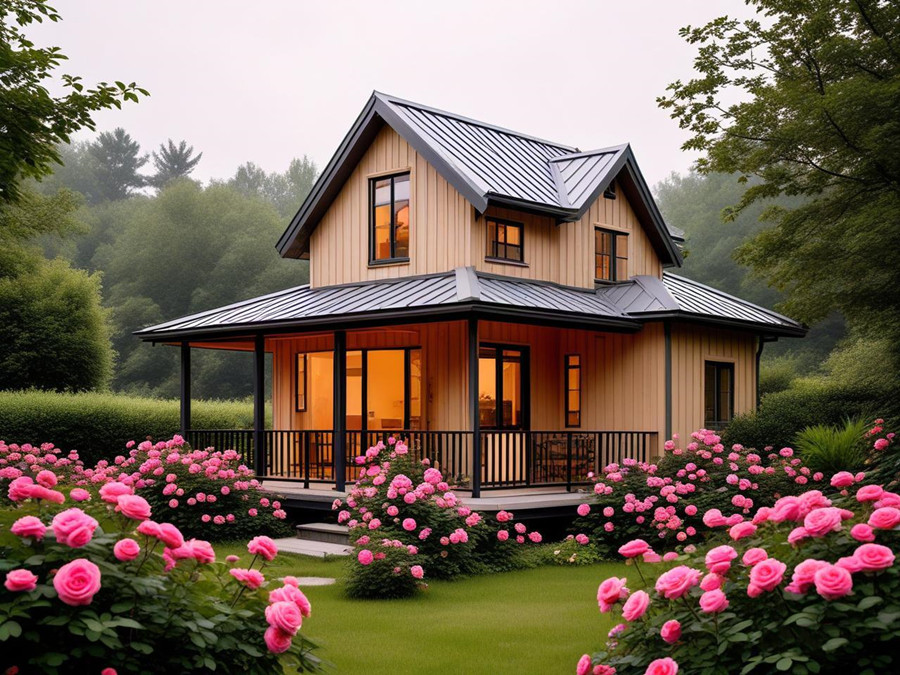As temperatures rise and humidity increases during the spring-summer transition, moisture control becomes critical for light-steel villas. Effective moisture management not only ensures comfort but also extends the villa’s lifespan. Below is a comprehensive guide to safeguarding your light-steel villa from dampness.

1. Material Selection and Application
Key Materials for Moisture Resistance:
- Moisture-Proof Breathable Paper: Applied to walls, this material blocks external humidity while expelling indoor moisture, acting as a protective barrier.
- Aluminum Foil-Faced Insulation: Installed on roofs, it reflects heat and seals out humid air. Its impermeable surface prevents condensation buildup.
- Ground Moisture Barriers: Placed at wall-floor joints, these barriers block rising groundwater and protect metal structures from corrosion.
Ruijie Light-Steel Standards:
Ruijie villas integrate materials with ISO-certified moisture resistance, ensuring structural integrity even in high-humidity climates.
2. Structural Design Strategies
Layered Defense Systems:
- Vapor Retarders: Installed between insulation and structural panels, these layers meet strict waterproofing and vapor permeability standards.
- Sealed Openings: Use self-adhesive waterproof membranes or metal flashing around windows, doors, and roof penetrations to eliminate leaks.
- Ventilated Roof Cavities: Design air gaps between roofing materials to promote airflow, preventing trapped moisture. Protective mesh screens deter pests.
Cold Climate Adaptations:
In colder regions, install vapor barriers on the warm side (indoor-facing) of insulation to prevent condensation within walls.
3. Daily Maintenance and Monitoring
Routine Checks:
- Inspect seals around windows/doors monthly; replace damaged weatherstripping promptly.
- Audit roof and wall waterproofing biannually, especially after heavy rains.
Indoor Humidity Control:
- Ventilation: Use cross-ventilation on dry days or install energy recovery ventilators (ERVs) for continuous airflow.
- Dehumidifiers: Deploy in basements or high-moisture zones during prolonged wet spells.
- Natural Absorbents: Place charcoal or silica gel packs in closets and corners to reduce ambient humidity.
Hygiene Practices:
Avoid clutter accumulation, which traps moisture and fosters mold. Clean surfaces regularly with antimicrobial solutions.
4. Emergency Measures for Extreme Weather
Pre-Storm Preparedness:
- Clear gutters and drainage systems to prevent water pooling.
- Seal all openings and test sump pumps if applicable.
Post-Rain Responses:
- Use industrial dehumidifiers to dry flooded areas within 24–48 hours, preventing mold growth.
- Treat mold-infested surfaces with hydrogen peroxide or vinegar solutions, followed by UV-C light sterilization.
5. Long-Term Sustainability
Eco-Friendly Upgrades:
- Install smart humidity sensors linked to ventilation systems for automated climate control.
- Opt for photocatalytic coatings on exterior walls, which break down organic pollutants and resist moisture.
Recyclability:
Over 85% of Ruijie villa components (e.g., steel frames, insulation) are recyclable, aligning moisture resistance with environmental stewardship.
Conclusion
Moisture prevention in light-steel villas demands a holistic approach—combining advanced materials, intelligent design, proactive maintenance, and adaptive technologies. By adopting these strategies, homeowners can ensure a dry, healthy living environment while maximizing their villa’s durability.